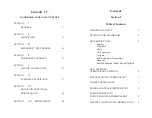
15
WEIGHT AND BALANCE
Nothing affects the way a plane flies more than
weight and balance. Failure to perform this
procedure may result in an aircraft that is at best
difficult to control and at worst impossible to fly.
Even small changes in the balance point make
large changes in stability. For your first flights
we recommend using a balance point at the
forward end of the center of gravity {C.G.} range,
this location will provide the most stability. As
your comfort and skill increase, slowly move the
C.G. aft to increase the control response.
The recommended starting range for the C.G. is
2 1/4 inches to 2 1/2 inches back from the
leading edge of the TOP wing measured at the
TIPS. This measurement may also be taken at
approximately ¾ inch in FRONT of the servo
wire exit holes in the top wing center section.
PLEASE NOTE. THE CG MUST BE
ESTABLISHED WITHOUT ANY FUEL IN
THE TANK
CONTROL THROWS
With your radio on, center all trims and adjust
the clevises so all control surfaces are straight.
Measure the control surface movement at the
widest part of each surface. Use the servo horns
and surface horn holes to adjust the control
throw. For your first flights the control throws
should be set to the following:
Surface
Low
High
Elevator
1
¼”
up
1
¾”
up
1
½”
down
2
¼”
down
Rudder
1/4 throw
1/2 throw
Aileron
1
“
up/down
2
”
up/dn
It is important to double check that all controls
move in the proper direction.
For 3 D flying you may consider using:-
Aileron
2 ½ inches
Rudder
Full throw
Elevator
Up to 4 inches
WE STRONGLY SUGGEST that you consider
using 30% expo on Low and High rate settings
and much higher Expo rates if using 3 D settings.
ENGINE SET UP
Be sure the engine is properly broken in using
the manufacture instructions. Set the throttle
throw to shut the motor off when the trim is
pulled down and idles reliably with the trim up
.
CONGRADULATIONS, you are now ready for
test flights.
Before leaving for the field be sure your batteries
are fully charged and you have all the required
support equipment {fuel, starter, glow driver,
etc.}.
Although the Pitts Python will fly well in wind,
wait for a nice day.
At the field have a helper hold the airplane;
following the radio manufactures instructions
perform a range check of the radio. Do this with
the motor off, start the motor and do it again.
Perform this test EVERY TIME YOU GO TO
FLY!
I would suggest making the first flight a little
short. Land and thoroughly inspect the plane to
ensure that all connections, etc remain tight.
Make any minor radio adjustment and
GO FOR IT……. Have fun……

































